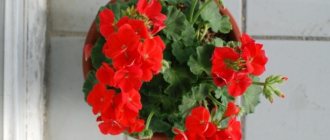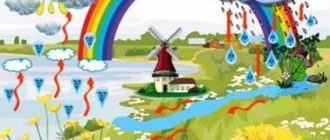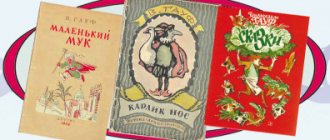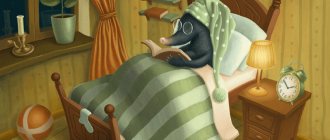A fairy tale about indoor plants for preschoolers
Fairy tale for children 5-7 years old
Educational fairy tale for preschool children “Green Hedgehog”
Author: Natalya Mikhailovna Golyshevskaya, senior teacher of MBDOU “Kindergarten No. 12” in Barnaul Purpose: this material is intended for preschool children Purpose: to expand preschoolers’ ideas about indoor plants Objectives: - to introduce children with features of appearance, structure, growing conditions of indoor plants; — teach how to perform labor actions to care for indoor plants; - develop curiosity, cognitive interest. Once upon a time there lived a Little Cactus. It was round, green and prickly. That's why they called him the Green Hedgehog. But he was prickly only on the outside, but in fact, the Cactus Child was very kind and sympathetic.
Recently, the owner separated him from his mother Cactus and planted him in a beautiful small pot. The little cactus liked his new house, but one thing upset him: plants unknown to him grew around him in large flower pots. But Little Cactus was sociable and inquisitive. He decided to get to know his “neighbors” better, because the Green Hedgehog so wanted to have friends! The first person the Cactus Kid dared to talk to was a plant with a thick, woody trunk, the round leaves of which looked like coins.
“Excuse me, please,” said the Green Hedgehog, a little embarrassed, “what is your name?” “People call me the money tree, people believe that I bring wealth and prosperity to the house, but scientifically I am called the tree crassula,” answered the tree. My homeland is the African savannah, so I love the sun. I also love it when my pot is turned from time to time, then I grow into a slender and beautiful tree. - Tell me, aren’t you bored of standing on the windowsill all the time? - asked Cactus. - No, of course, in winter I can watch what is happening outside the window, and in the warm season they send me “to the dacha,” that is, they take me out into the fresh air - onto the balcony. Here another plant with unusually beautiful leaves, on which bright red veins and spots stood out, intervened in the conversation: “And my name is arrowroot, I really love humidity and am afraid of direct sunlight, so I like it when the owner sprays my leaves with lukewarm water.” And I can also pick up leaves and fold them at dusk and even a few hours before rain, like a real barometer.
The little cactus listened very carefully to the stories of the plants, because he was still small and did not know much. An unusual plant grew in one of the pots; its dark green sword-shaped leaves with a pointed apex and light transverse stripes resembled fish scales. It turned out that this is a sansevieria, which is simply called “pike tail”. The little cactus even felt a little funny when he heard this name.
Suddenly the door opened and the hostess entered the room. In her hands was a pot with a very beautiful plant. “Meet this, this is your new neighbor,” she said (the owner often talked to her pets, because she believed that flowers, like living beings, understand everything and love when you communicate with them) “this is a fern. It will not only decorate the room, but also help clean the air from dust and harmful substances. It’s just a pity that the ferns don’t bloom, but they delight you with their varied leaves: huge, tiny and even curly.
The hostess put the pot down and left. So a “newbie” appeared on the windowsill. He quickly got used to the new environment and proudly talked about the fact that ferns are the oldest inhabitants of the Earth, existed along with dinosaurs and have survived to this day. So the Green Hedgehog not only met his “neighbors”, but also learned a lot of interesting and useful things.
We recommend watching:
For preschoolers about the seasons. A fairy tale about how Winter got lost. Summary of the GCD in the preparatory group on the topic “Getting to know the emotions.” A fairy tale for preschoolers. Shishkinsky Ponds Ecological fairy tale for children 6-9 years old
Similar articles:
A fairy tale about kindness for older preschoolers
Developing interest in folk art through familiarization with Russian folk tales in children of primary preschool age
Joyful Flower. fairy tale for kids
Spring has come.
In a dark dense forest, on the ground covered with dry spruce and pine needles, a very beautiful and delicate Flower grew. It was yellow and bright, like the spring sun that it had never seen. But the flower did not lose heart. He smiled and sang funny songs. It’s a pity, but no one in the dark and dense forest saw him or heard him sing. The Flower became bored, and he went through the forest to look for friends. He goes and hums his song. Worm heard his ringing voice. He crawled out of the ground into the light to look at the singer. And the Flower, seeing the Worm, was delighted and said to him: “Worm, worm!” Let's be friends with you! “No, that’s impossible,” answered the Worm. “You don’t want to follow me into the ground.” And I live there, and that’s where my home is. - How do you crawl there, Worm? - Yes, very simple. I make passages underground. They look like tunnels. - No. I don't want to crawl underground with you. “I’d better look for a friend on earth,” Flower decided and moved on. He goes on and hums his song. The Caterpillar, who was sitting on the trunk of a pine tree, saw him. She crawled closer and listened. – You sing beautifully, Flower! - speaks. – If you like it, then maybe you’ll want to be friends with me? “No,” answered the Caterpillar. “I won’t be able to keep up with you.” Look how fast you are. You run like you fly! “Well, as you know,” said the Flower and moved on. He walked and walked all day, but still couldn’t find any friends. The dark forest grew even darker and night fell. The Flower fell asleep, and in the morning he again went in search of friends. He goes and sings his song. And then he finally got lucky. A Crow flew next to him. She heard the Flower’s song and said: “You, Flower, will not find a friend for yourself in this dark forest.” Come on, I'll take you to the clearing. Sunny loves to go there. And the Sun is loved by bees, butterflies and dragonflies, grasshoppers and bugs. They all gather there in the clearing. - Tell me, Vorona, will they want to be friends with me? - Of course they will! After all, you are so joyful! Crow brought Flower to a sunny meadow. And there - bees are buzzing, butterflies and moths are fluttering, grasshoppers are chirping! Oh, how fun, how interesting! – What a beautiful Flower, it’s like a little Sun! – they all rang and buzzed in different voices. They surrounded the Flower, looked at it and couldn’t get enough of it. After all, coming out of the darkness into the sunlight, it became even more beautiful and brighter! The Flower smiled and asked: “Bees, dragonflies, butterflies and moths!” Will you be friends with me? - Of course we will! You are so cheerful and joyful! The Flower was delighted, spread out all its delicate bright yellow petals, looked at the Sun, straightened the green cap on its head and sang: Everyone lives happily in the sunny meadow. They lead round dances and sing songs. And I am such a beautiful and joyful Flower! I will sing you a song and tell you a poem. And everyone who once came to me here will understand that you will never see such a clearing!
The sun listened to this joyful song of the Flower and smiled. And midges, butterflies and moths, bees and bugs danced. Soon the whole clearing was in bloom! Many, many green blades of grass grew on it, and between them hundreds of babies opened their thin petals - flowers as delicate and beautiful as the bright yellow joyful Flower. The sun painted them in all the colors of the rainbow - purple, blue, light blue, green, yellow, pink, red, burgundy. Oh, how fun it was in the sunny meadow, how beautiful! Now every day all the flowers sing funny songs, and bees, bugs, butterflies and dragonflies dance and kiss their beautiful heads. And if you ever find such a cheerful and beautiful sunny clearing in the forest, then, of course, you will definitely see that very beautiful and Joyful Flower on it!
Source
read fairy tales about flowers
It's time to sleep
The last fairy tale from Alyonushka's fairy tale series tells about a wonderful world where a girl goes in her dreams. There she will meet talking flowers, travel to distant lands, fly on a ladybug and even meet Grandfather...
Snail and rose
Hans Christ. Andersen
Andersen's fairy tale about a beautiful rose bush, which was fragrant with flowers every year, enjoying every day, and about a snail living under the bush and spitting on the world around... The snail and the rose read Around the garden there was a hedge of...
Violet at the North Pole
A short tale about a violet that found itself alone in the ice. The animals marveled at the unusual phenomenon for them. And the violet decided to melt all the ice alone, but she did not have enough strength... Violet at the North Pole read One morning...
Five from one pod
Hans Christ. Andersen
The fairy tale tells about five peas that lived in one pod until a boy picked them. They all ended up in different places. And their fates ended differently. The story of the fifth pea, which fell into the crack under...
Little Ida's flowers
Hans Christ. Andersen
One day she asked a student why her flowers were wilting. He told her a wonderful story about flower balls. That same night, Ida woke up and saw a beautiful flower ball, to which even dolls came... Little flowers...
Nightingale and rose
The Nightingale and the Rose is a sad story about love and self-sacrifice, about cold calculation and true service to beauty. The little nightingale decides to help the Student get the love of a girl. To do this, he will have to sing all night with a thorn in...
How does aloe heal?
Aloe contains the medicinal substance aloin in its juice . It is aloin that heals, healing wounds, improving appetite, restoring digestion. Since the substance “aloin” has anti-microbial properties, it is used to treat runny noses.
Aloin is more abundant in older lower leaves. You need to cut the leaf, remove the skin from it and apply it to the wound. After a couple of hours, change the leaf. Repeat several times. Show the children how it's done. Treat a doll whose hand wound is not healing. If children are involved in the process, it is worth recalling the bitterness of aloe juice. After aloe, you need to wash your hands thoroughly with soap and wash your face with water.
If the cut leaf is placed in the refrigerator and kept there for 2-3 weeks, the leaves produce special substances (biogenic stimulants) that enhance the skin restoration process.
CAREFULLY! For oral administration, aloe juice is mixed with honey, since the juice is very bitter. Aloe should be used internally with caution. You should not drink it at night as it interferes with sleep. There are a number of serious contraindications to taking it, so it is better to consult your doctor first.
Why is aloe called agave?
“He will decorate the house for a whole century, And he will heal everyone in that house. That flower is unsightly in appearance, But it is famous as a healer.” (Aloe.)
Aloe has a second name - “ agave”. It is connected with the belief that aloe blooms only once every hundred years. And then he dies. Alexander Kuprin even reflected this fact in the story “Stoletnik”.
But this is a misconception. It’s just very difficult to create the same conditions in our homes as in his homeland - in Africa, beyond the Kalahari Desert in the Cape Land. Aloe blooms there every year. Want to see what aloe flowers look like?
It turns out that such a gnarled creature as aloe has beautiful flowers!
The stem of aloe is uneven, curved, and dry scales are visible on it - the remains of old leaves. African tribes have a legend about how aloe came into being and why this plant has this shape.
Summary of the lesson “For children about flowers”
Yulia Gumashyan
Summary of the lesson “For children about flowers”
Children about flowers
Goal: Consolidation and generalization of children's knowledge about colors .
Instill in children a love of nature and teach them to admire beauty. Teach children to recognize flowers , know their name and flower (stem, root, leaves, flower )
.
Explain to children the benefits of flowers .
Make a joint application.
Materials: Colored paper , scissors, glue, Whatman paper, cards with flowers .
Proverbs and sayings about aloe
Proverbs about aloe are related to its bitterness.
They say about aloe: “You can’t get enough of aloe,” “You can’t make aloe sweet.” Aloe indeed has very bitter juice. You can even try it a little on your tongue to make sure of this. In medicines, aloe juice is mixed with honey, but even this does not help.
Why is aloe so bitter? Let the children answer this question themselves.
Let's discuss another saying: “More bitter than aloe.” In what cases do they say this? When something bad happens, something difficult happens, when trouble happens, the hero loses something. Let us recall with our children the moments in fairy tales when what happened to the characters could be described by the saying “Worder than aloe.” For example, when the hero experienced a feeling of loss. When Ivan Tsarevich burned the frog's skin and lost his Vasilisa. When Martyn’s magic ring was stolen by Ulyana, and he himself was thrown into prison. When Snow White fell into eternal sleep and the seven dwarfs put her in a crystal coffin. When the queen and her son Guidon were tarred in a barrel and sent into the ocean. But it is important to emphasize that this state is surmountable, even if it seems to the hero that everything is over, there is always a way out of a difficult situation.
Experiments with aloe. Why does aloe have such leaves?
Aloe is a leafy succulent. Let's look at aloe leaves with the children. Old leaves and young leaves will be different from each other. Let the children observe the plant and find the differences.
Differences between young and old aloe leaves.
1. Color. Young leaves are bright and green. Old leaves of aloe are lighter, as if some kind of whitish coating has been applied to them. A similar coating can be seen on plums. This is wax. Wax reduces water evaporation. And it protects aloe from the scorching sun no worse than sunscreen.
Experiment with aloe 1. Drop some water onto an aloe leaf and see how a drop rolls off the leaf. Because the aloe leaf is covered with wax. Moreover, the shape of the aloe leaf is such that water flows to the roots of the plant.
Aloe experiment 2. If we throw an aloe leaf into water, it will turn silver. Air bubbles form around the leaf.
Aloe experiment 3. Rub the plaque on old aloe leaves with your finger. What do we see? The leaf under the wax is as green as the young one.
The young aloe leaf has not yet produced much wax, but over time it will also be covered with a protective waxy layer. In the meantime, the baby, a leaf, is growing, he is breathing intensely. Wax slows down not only evaporation through pores (stomata), but also respiration. That’s why we don’t yet see a waxy coating on young leaves, because they need to grow and breathe.
2. Thorns. In old aloe leaves, the leaf edges have pronounced and rough spines. With age, the leaves become coarser, the spines become more and more rigid. And this is not surprising! After all, it is in old leaves that water is stored!
Young leaves appear during the rainy season. At this time there is a lot of other green food around, so the animals are not very interested in leaves. And they may not protect themselves with thorns.
3. Differences between old and young aloe leaves in leaf shape.
Old and young leaves differ in shape. The old leaf forms a hump, convex at the top. And the young one forms a hollow. I wonder why this happens?
The reason is that in old aloe leaves the pulp grows, more water is stored in them, and the leaf gains volume. If we cut the leaf crosswise, we will see that the inside of the aloe leaf is filled as if with gel or jelly. Water is stored in small bags. I wonder why the gel and not the juice, like in orange fruits? Let's conduct an experiment to answer this question.
Experiment with aloe 4. Drop a drop of water, and next to it, drop a drop of gel-like aloe juice onto the glass and leave them for a couple of hours. When the time is up, together with the children we will look at the results of our experiment and discuss them.
What do we see? The drop of water evaporated and dried, but the gel remained watery. This means that the gel helps the plant retain moisture!
People came up with the idea of using the gel to grow moisture-loving plants. (Show your child the hydrogel balls for indoor plants)
Riddles about aloe for children
“Green, prickly, dense for a hundred years, As soon as a runny nose takes you by surprise, you run to it as fast as you can! (Aloe)"
“It has thorns, but does not know how to wound, But it heals us at any hour. (Aloe)."
“A leaf with a hump and a groove, It has thorns, but does not know how to wound, But it heals us at any hour. (Aloe)"
“The leaves are prickly, always covered in needles. It’s like a fountain growing out of a pot” (Aloe)
He will decorate the house for a whole century, And he will heal everyone in that house. That flower is unsightly in appearance, but famous as a healer.







